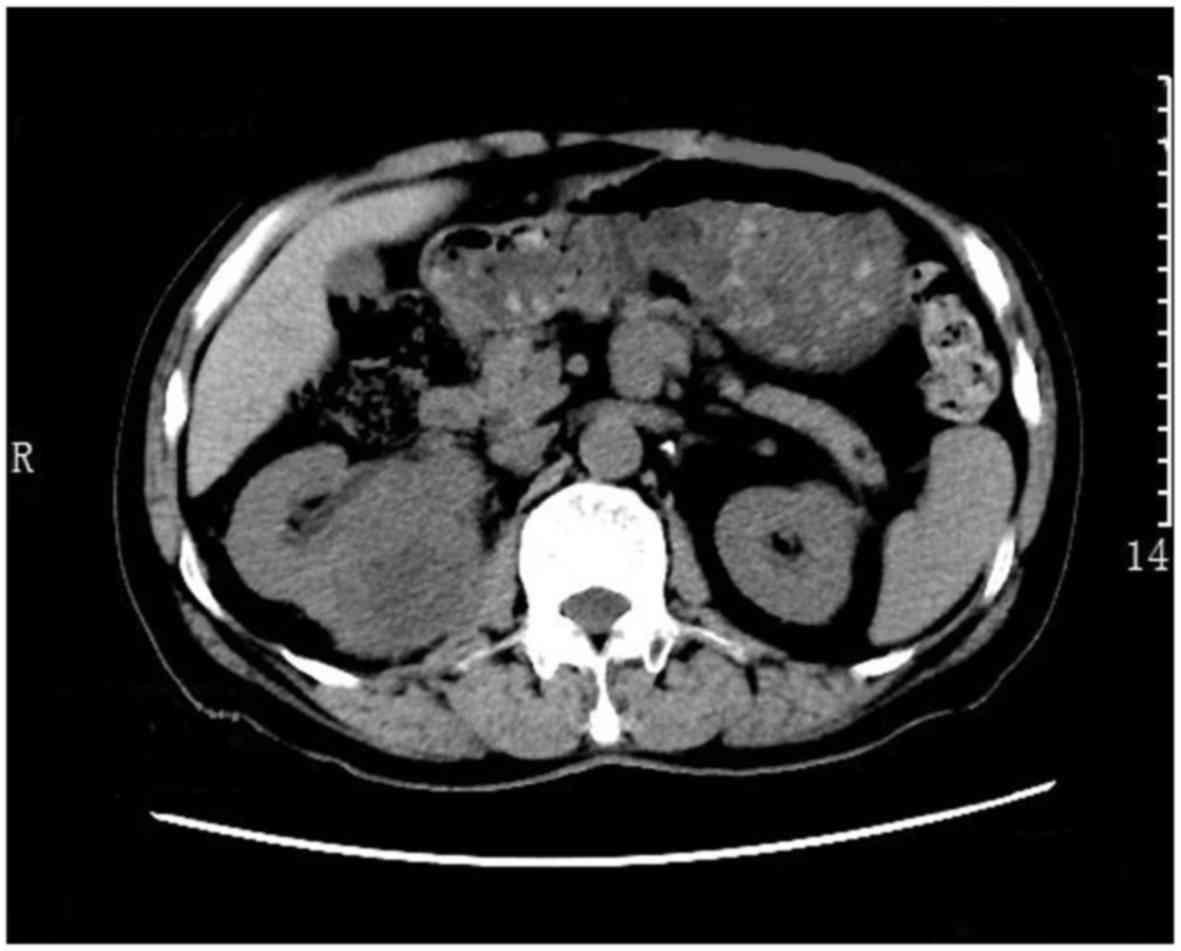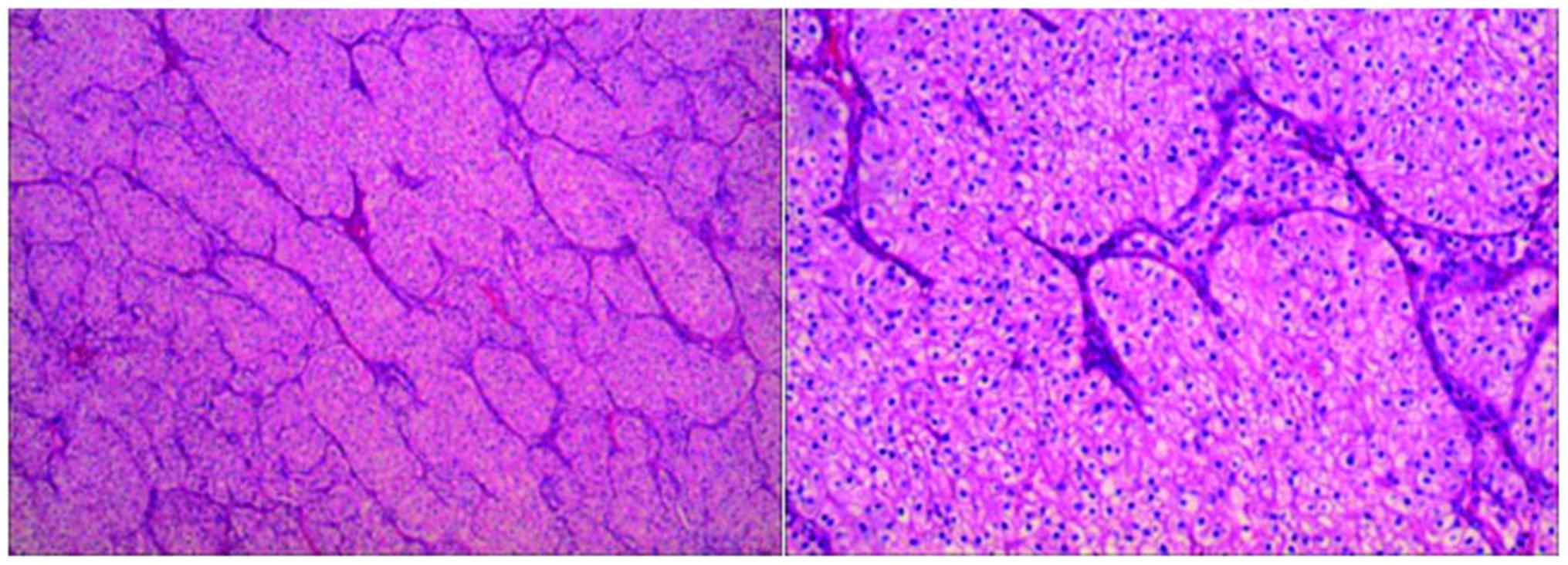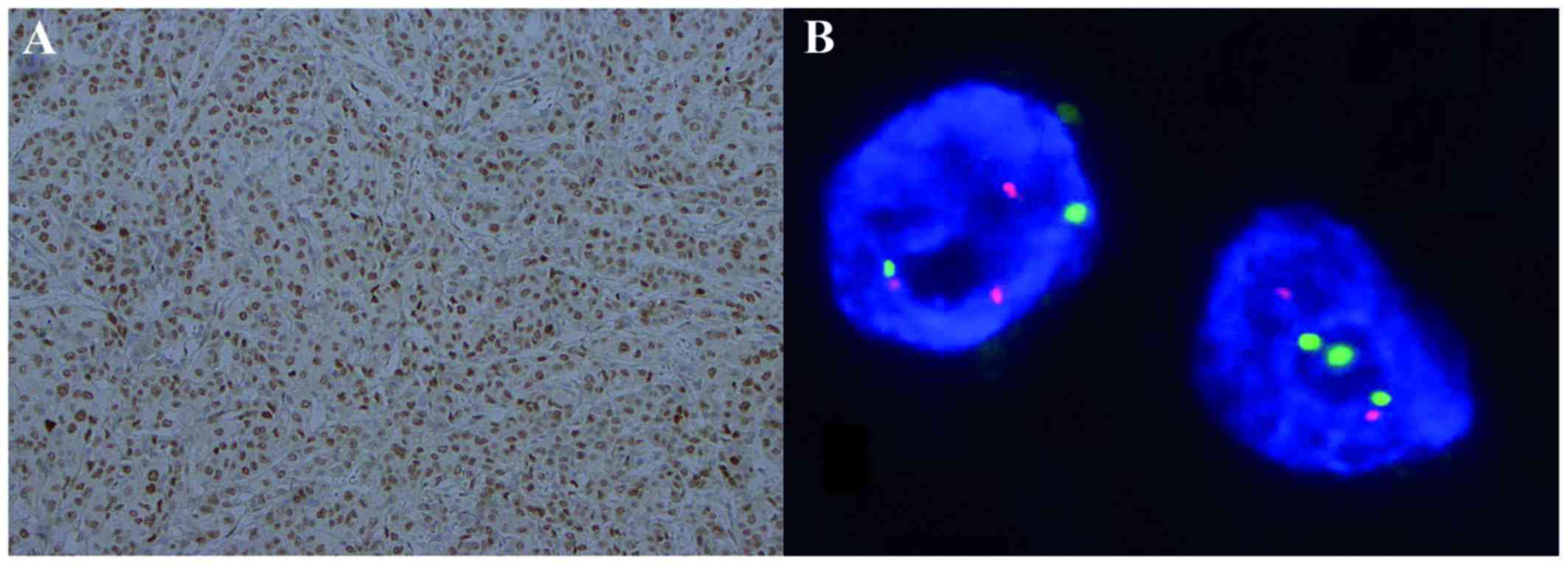|
1
|
Verhoest G, Veillard D, Guillé F, De La
Taille A, Salomon L, Abbou CC, Valéri A, Lechevallier E, Descotes
JL, Lang H, et al: Relationship between age at diagnosis and
clinicopathologic features of renal cell carcinoma. Eur Urol.
51:1298–1304. 2007. View Article : Google Scholar : PubMed/NCBI
|
|
2
|
Bruder E, Passera O, Harms D, Leuschner I,
Ladanyi M, Argani P, Eble JN, Struckmann K, Schraml P and Moch H:
Morphologic and molecular characterization of renal cell carcinoma
in children and young adults. Am J Surg Pathol. 28:1117–1132. 2004.
View Article : Google Scholar : PubMed/NCBI
|
|
3
|
Qiu Rao, Bing Guan and Zhou XJ: Xp11.2
translocation renal cell carcinomas have a poorer prognosis than
non-Xp11.2 translocation carcinomas in children and young adults: A
meta-analysis. Int J Surg Pathol. 18:458–464. 2010. View Article : Google Scholar : PubMed/NCBI
|
|
4
|
Kmetec A and Jeruc J: Xp 11.2
translocation renal carcinoma in young adults; recently classified
distinct subtype. Radiol Oncol. 48:197–202. 2014. View Article : Google Scholar : PubMed/NCBI
|
|
5
|
Komai Y, Fujiwara M, Fujii Y, Mukai H,
Yonese J, Kawakami S, Yamamoto S, Migita T, Ishikawa Y, Kurata M,
et al: Adult Xp11 translocation renal cell carcinoma diagnosed by
cytogenetics and immunohistochemistory. Clin Cancer Res.
15:1170–1176. 2009. View Article : Google Scholar : PubMed/NCBI
|
|
6
|
Argani P and Ladanyi M: Translocation
carcinomas of the kidney. Clin Lab Med. 25:363–378. 2005.
View Article : Google Scholar : PubMed/NCBI
|
|
7
|
Klatte T, Streubel B, Wrba F, Remzi M,
Krammer B, de Martino M, Waldert M, Marberger M, Susani M and
Haitel A: Renal cell carcinoma associated with transcription factor
E3 expression and Xp11.2 translocation: Incidence, characteristics,
and prognosis. Am J Clin Pathol. 137:761–768. 2012. View Article : Google Scholar : PubMed/NCBI
|
|
8
|
Srigley JR, Delahunt B, Eble JN, Egevad L,
Epstein JI, Grignon D, Hes O, Moch H, Montironi R, Tickoo SK, et
al: The international society of urological pathology (ISUP)
vancouver classification of renal neoplasia. Am J Surg Pathol.
37:1469–1489. 2013. View Article : Google Scholar : PubMed/NCBI
|
|
9
|
Sukov WR, Hodge JC, Lohse CM, Leibovich
BC, Thompson RH, Pearce KE, Wiktor AE and Cheville JC: TFE3
rearrangements in adult renal cell carcinoma: Clinical and
pathologic features with outcome in a large series of consecutively
treated patients. Am J Surg Pathol. 36:663–670. 2012.PubMed/NCBI
|
|
10
|
Wang W, Ding J, Li Y, Wang C, Zhou L, Zhu
H and Peng W: Magnetic resonance imaging and computed tomography
characteristics of renal cell carcinoma associated with Xp11.2
translocation/TFE3 gene fusion. PLoS One. 9:e999902014. View Article : Google Scholar : PubMed/NCBI
|
|
11
|
Liu K, Xie P, Peng W and Zhou Z: Renal
carcinomas associated with Xp11.2 translocations/TFE3 gene fusions:
Findings on MRI and computed tomography imaging. J Magn Reson
Imaging. 40:440–447. 2014. View Article : Google Scholar : PubMed/NCBI
|
|
12
|
Ellati RT, Abukhiran I, Alqasem K, Jasser
J, Khzouz J, Bisharat T, Al-Saidi I and Al-Daghmin A:
Clinicopathologic features of translocation renal cell carcinoma.
Clin Genitourin Cancer. 15:112–116. 2017. View Article : Google Scholar : PubMed/NCBI
|
|
13
|
Rao Q, Williamson SR, Zhang S, Eble JN,
Grignon DJ, Wang M, Zhou XJ, Huang W, Tan PH, Maclennan GT and
Cheng L: TFE3 break-apart FISH has a higher sensitivity for Xp11.2
ranslocation-associated renal cell carcinoma compared with TFE3 or
cathepsin K immunohistochemical staining alone: Expanding the
morphologic spectrum. Am J Surg Pathol. 37:804–815. 2013.
View Article : Google Scholar : PubMed/NCBI
|
|
14
|
Rao Q, Chen JY, Wang JD, Ma HH, Zhou HB,
Lu ZF and Zhou XJ: Renal cell carcinoma in children and young
adults: Clinicopathological, immunohistochemical, and VHL gene
analysis of 46 cases with follow-up. Int J Surg Pathol. 19:170–179.
2011. View Article : Google Scholar : PubMed/NCBI
|
|
15
|
Dey B, Badhe B, Govindarajan KK and Ramesh
RA: Xp11.2 translocation renal cell carcinoma diagnosed by
immunohistochemistry and cytogenetics. J Lab Physicians. 8:123–125.
2016. View Article : Google Scholar : PubMed/NCBI
|
|
16
|
Green WM, Yonescu R, Morsberger L, Morris
K, Netto GJ, Epstein JI, Illei PB, Allaf M, Ladanyi M, Griffin CA
and Argani P: Utilization of a TFE3 break-apart FISH assay in a
renal tumor consultation service. Am J Surg Pathol. 37:1150–1163.
2013. View Article : Google Scholar : PubMed/NCBI
|
|
17
|
Xu L, Yang R, Gan W, Chen X, Qiu X, Fu K,
Huang J, Zhu G and Guo H: Xp11.2 translocation renal cell
carcinomas in young adults. BMC Urol. 15:572015. View Article : Google Scholar : PubMed/NCBI
|
|
18
|
Ahluwalia P, Nair B and Kumar G: Renal
cell carcinoma associated with Xp11.2 translocation/TFE3 gene
fusion: A rare case report with review of the literature. Case Rep
Urol. 2013:8105902013.PubMed/NCBI
|
|
19
|
Song HC, Sun N, Zhang WP, He L, Fu L and
Huang C: Biological characteristics of pediatric renal cell
arcinoma associated with Xp11.2 translocations/TFE3 gene fusions. J
Pediatr Surg. 49:539–542. 2014. View Article : Google Scholar : PubMed/NCBI
|
|
20
|
Kakoki K, Miyata Y, Mochizuki Y, Iwata T,
Obatake M, Abe K, Nagayasu T and Sakai H: Long-term treatment with
sequential molecular targeted therapy for Xp11.2 translocation
renal cell carcinoma: A case report and review of the literature.
Clin Genitourin Cancer. 15:e503–e506. 2017. View Article : Google Scholar : PubMed/NCBI
|
|
21
|
Sudour-Bonnange H, Leroy X, Chauvet MP,
Classe M, Robin PM and Leblond P: Cutaneous metastases during an
aggressive course of Xp11.2 translocation renal cell carcinoma in a
teenager. Pediatr Blood Cancer. 61:1698–1700. 2014. View Article : Google Scholar : PubMed/NCBI
|












